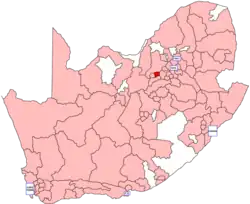Potchefstroom (House of Assembly of South Africa constituency)
| Potchefstroom | |
|---|---|
| Former constituency for the South African House of Assembly | |
 Location of Potchefstroom within South Africa (1981) | |
| Province | Transvaal |
| Electorate | 23,083 (1992 by) |
| Former constituency | |
| Created | 1910 |
| Abolished | 1994 |
| Number of members | 1 |
| Last MHA | A. S. Beyers (CP) |
| Replaced by | North West |
Potchefstroom was a constituency in the Transvaal Province of South Africa, which existed from 1910 to 1994. It covered a part of the western Transvaal centred on the town of Potchefstroom. Throughout its existence it elected one member to the House of Assembly and one to the Transvaal Provincial Council.
Franchise notes
When the Union of South Africa was formed in 1910, the electoral qualifications in use in each pre-existing colony were kept in place. In the Transvaal Colony, and its predecessor the South African Republic, the vote was restricted to white men, and as such, elections in the Transvaal Province were held on a whites-only franchise from the beginning. The franchise was also restricted by property and education qualifications until the 1933 general election, following the passage of the Women's Enfranchisement Act, 1930 and the Franchise Laws Amendment Act, 1931. From then on, the franchise was given to all white citizens aged 21 or over. Non-whites remained disenfranchised until the end of apartheid and the introduction of universal suffrage in 1994.[1]
History
Like most of the rural Transvaal, Potchefstroom had a largely Afrikaans-speaking electorate. In its early days, it was a marginal seat, seeing tight contests between the National and South African parties, before going through a brief period of United Party dominance in the 1930s and 40s. In 1948, it was captured by Johan Heinrich Steyn of the Afrikaner Party, who soon joined the governing National Party - from then on, it became a safe seat for the NP. Its longest-serving MP, Louis le Grange, was first elected in 1966, and served as a cabinet minister under John Vorster and P. W. Botha before being made Speaker of the House of Assembly in 1987. He died in office in 1991, and the resulting by-election was won by the Conservative Party - coming shortly before the referendum on ending apartheid, this was seen as a major setback for the governing party.
Members
| Election | Member | Party | |
|---|---|---|---|
| 1910 | J. A. Neser | Het Volk | |
| 1915 | G. W. Holl | South African | |
| 1915 by | N. J. de Wet | ||
| 1920 | |||
| 1921 | J. G. Obermeyer | National | |
| 1924 | M. L. Fick | ||
| 1929 | |||
| 1933 | |||
| 1934 | United | ||
| 1938 | Hubert van der Merwe | ||
| 1943 | |||
| 1948 | J. H. Steyn | Afrikaner | |
| 1953 | National | ||
| 1958 | |||
| 1961 | |||
| 1966 | Louis le Grange | ||
| 1970 | |||
| 1974 | |||
| 1977 | |||
| 1981 | |||
| 1987 | |||
| 1989 | |||
| 1992 by | A. S. Beyers | Conservative | |
| 1994 | Constituency abolished | ||
Detailed results
Elections in the 1910s
| Party | Candidate | Votes | % | ±% | |
|---|---|---|---|---|---|
| Het Volk | J. A. Neser | 1,260 | 73.3 | New | |
| Unionist | R. J. E. Orpen | 458 | 26.7 | New | |
| Majority | 802 | 46.6 | N/A | ||
| Het Volk win (new seat) | |||||
| Party | Candidate | Votes | % | ±% | |
|---|---|---|---|---|---|
| South African | G. W. Holl | 1,043 | 56.8 | −16.5 | |
| National | W. J. de Klerk | 794 | 43.2 | New | |
| Majority | 249 | 13.6 | N/A | ||
| Turnout | 1,837 | 82.5 | N/A | ||
| South African hold | Swing | N/A | |||
Elections in the 1920s
| Party | Candidate | Votes | % | ±% | |
|---|---|---|---|---|---|
| South African | N. J. de Wet | 1,127 | 51.2 | −5.6 | |
| National | J. G. Obermeyer | 1,074 | 48.8 | +5.6 | |
| Majority | 53 | 2.4 | −11.2 | ||
| Turnout | 2,201 | 69.8 | −12.7 | ||
| South African hold | Swing | -5.6 | |||
| Party | Candidate | Votes | % | ±% | |
|---|---|---|---|---|---|
| National | J. G. Obermeyer | 1,319 | 51.0 | +2.2 | |
| South African | N. J. de Wet | 1,269 | 49.0 | −2.2 | |
| Majority | 50 | 2.0 | N/A | ||
| Turnout | 2,588 | 73.6 | +3.8 | ||
| National gain from South African | Swing | +2.2 | |||
References
- ^ "EISA South Africa: Historical franchise arrangements". Eisa.org.za. Archived from the original on 9 May 2013. Retrieved 6 July 2012.
- ^ Schoeman, B.M. (1977). Parlementêre verkiesings in Suid-Afrika 1910-1976. Pretoria: Aktuele Publikasies.
- ^ Standard Encyclopaedia of Southern Africa (1972). "House of Assembly" (vol. 5, pp. 617–636). Cape Town: Nasionale Opvoedkundige Uitgewery (Nasou).
- ^ South Africa 1980/81: Official Yearbook of the Republic of South Africa. Johannesburg: Chris van Rensburg Publications.
- ^ South Africa 1983: Official Yearbook of the Republic of South Africa. Johannesburg: Chris van Rensburg Publications.
- ^ Government Gazette of South Africa, No. 10751. 22 May 1987. Pretoria: Government of South Africa.
- ^ Government Gazette of South Africa, No. 12109. 20 September 1989. Pretoria: Government of South Africa.